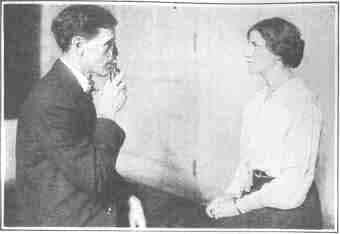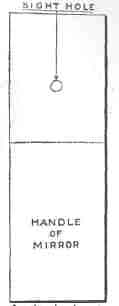Strengthening the Eyes
by Bernarr A. MacFadden А. Макфеден
CHAPTER XXVI
Test Your Own Eyes
IT does not require any special training, or even any expensive apparatus, to test the vision. With the aid of a Snellen test card any one can test his own sight, and with the assistance of a second person a retinoscope can be used.
A test card, which is sometimes difficult to buy, accompanies this course. You can also make one for yourself by painting black letters of an appropriate size on a white background. Directions for using the card for the purpose of testing the vision are given in Chapter XI, "Saving the Sight of the Children." Each eye should, of course, be tested separately.
A retinoscope can be even more easily made than a test card, all the material required for the purpose being a small piece of looking-glass about one inch wide and three inches long. A small mirror that will answer the purpose can be bought at the five-and-ten-cent stores, and a glass-cutter, which is as easy to use as a pair of scissors, can also be bought at these stores. For a few cents, too, a glazier, or painter, will cut a piece of mirror glass of the right size. About three-quarters of an inch from the top of this mirror, and midway between the sides, scrape off the silver backing on an area a little larger than the lead of a lead-pencil. If it is a little larger, or a little smaller than this, it will not matter. By means of the mirror the observer reflects light from a lamp, or other source of light, into the eye which is being examined, and the opening serves as a sight-hole through which he looks into the pupil. The room must be darkened, and the light placed a little behind and over the head of the subject.

Testing the eye with the retinoscope.
When the observer, who stands or is seated a few feet from the subject, looks through the sight-hole, he observes that the pupil, instead of being black, is more or less red. This is the color of the retina, which is not ordinarily seen, because the eye of the observer is not placed in position to receive the rays of light coining from the interior of the eye. When the light is moved slowly in different directions across the pupil, a dark shadow will be observed at the edge of the latter.
If the eye is near-sighted, this shadow moves in a direction opposite to that of the movements of the mirror. If it is far-sighted it moves in the same direction the mirror moves. If it is normal, the shadow remains stationary. When the shadow moves in one direction in one meridian, and in the opposite direction in another, the eye lias mixed astigmatism. The shadow may, for instance, go with the light when the mirror is moved up and down, and in an opposite direction to it when the mirror is moved from side to side. In the case of other kinds of astigmatism the observer may note that the shadow moves more decidedly in one meridian than in the other. When errors of refraction are corrected by glasses there will be no movement of the shadow.
The retinoscope can be used as an ophthalmoscope simply by lessening the distance between the observer and the subject. The principle is just the same as that involved in looking through a keyhole into a room. The closer you come to the keyhole the more you will see. At a distance of about half an inch, by looking a little toward the nasal side of the eye, one will begin to see the optic nerve, an area whiter than the rest of the interior of the eyeball and apparently about one-quarter of an inch in diameter. Radiating from the center one sees fine streaks of branching blood vessels, the darker being the veins, the lighter the arteries.
It requires no experience to make these observations, and children of ten have used the instrument successfully. The larger the pupil the easier it is, just as in the case of the keyhole. The larger the opening the more one sees in both cases. The normal eye is more easily examined than a defective one, and young adults than older or younger persons. The light should be thrown on the blind spot, the entrance of the optic nerve, as the pupil contracts when it is thrown on the center of sight. The red light should be seen constantly in the pupil. When it is lost the observer should withdraw a little and get it again, afterward bringing the instrument up close to the eye.

A simple homemade retinoscope, made by scratching a small hole in the silver back of a small mirror, to be used for self-testing in conjunction with another larger mirror.
There are also various other ways in which the vision can be tested. If the subject, when looking at the letters on the Snellen test card, can remember anything blacker, the vision is imperfect, no matter what the light, or the distance. Another way is to squint the eyes, or to look through a small opening, such as a hole in a card, or an opening between the fingers. If this enables you to see better, your vision is imperfect.
Everyone should have the means of making these simple tests, for eye troubles when not accompanied by discomfort, are insidious, and may make considerable progress before they are discovered. This is particularly apt to be the case if one eye is principally affected. So long as one has one fairly good eye to see with one may not observe that the other is falling behind, and when an eye once begins to do this it can hardly fail to lose function rapidly, simply because it does not get enough work to do. If errors of refraction are discovered at the beginning, they can be quickly corrected by the methods presented in this book; but if they are allowed to continue for years, they may be very difficult to cure. And if the eye is not allowed to develop any permanent errors of refraction and the general health is satisfactory, one need have no fear of organic diseases.
| Уход за глазамиФизикаНаука БейтсаТехнол.ФорумЛазер. коррек.Синя. под глаз.Зуд, жжения в глазахВраче. тайнаДр. болезни | |




